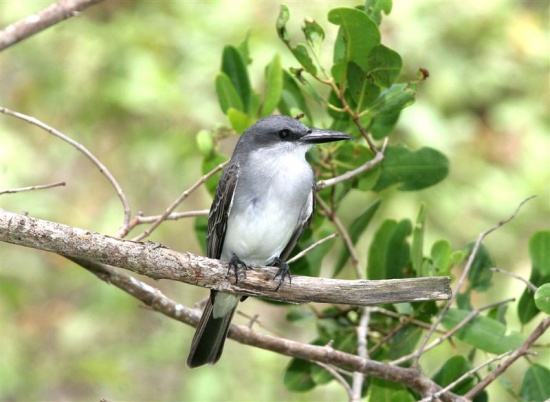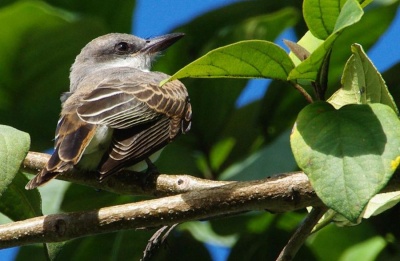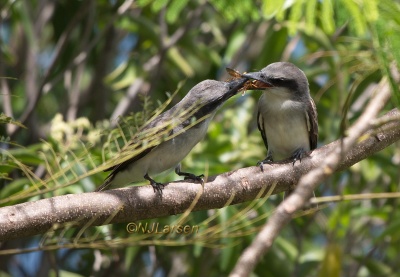m |
(→External Links: Added variant English names.) |
||
| (17 intermediate revisions by 8 users not shown) | |||
| Line 1: | Line 1: | ||
| − | + | [[Image:Grey_Kingbird.jpg|thumb|550px|right|Likely bird of subspecies ''dominicensis''<br /> Photo by {{user|Gallus|Gallus}} <br />[[Tobago]], March 2005]] | |
| − | [[Image:Grey_Kingbird.jpg|thumb| | + | ;[[:Category:Tyrannus|Tyrannus]] dominicensis |
==Identification== | ==Identification== | ||
| − | + | 21–25 cm<br /> | |
| + | Underparts of the Gray Kingbird are light grey to almost white, darkest on the upper breast. Upperside is medium gray with darker tail, primaries, and top of head. Tail shows a slight fork at the very end. The side of the head shows a more or less strongly contrasting black <nowiki>"bandits mask"</nowiki>. The bill is strong, black, and relatively wide at the base. In the crown is an area with a concealed yellow-orange patch, which very rarely is visible. | ||
| + | [[Image:057 2 edited-1.jpg|thumb|400px|right|Juvenile<br />Photo by {{user|Richard+Roach|Richard Roach}}<br />St James, [[Barbados]], October 2008]] | ||
| + | Field guides sometimes mention that there should be no yellow in the plumage apart from the concealed crown patch. That seems to be wrong, the undertail coverts, and less often the entire underside may look light yellowish to the human eye as well as to the camera; study of museum bird indicate that this feature is found in some juvenile birds. | ||
| + | ==Distribution== | ||
| + | Nominate subspecies is found from coastal [[Florida]] to northern [[South America]] and [[Trinidad]] including part of the [[Caribbean]], while subspecies ''vorax'' is found in the [[Lesser Antilles]]. Both subspecies are at least partial migrants in part of their ranges. | ||
| + | |||
| + | Rare to casual vagrant west along coastal to [[Texas]] and north along the Atlantic coast to the maritime provinces. | ||
| + | ==Taxonomy== | ||
| + | ====Subspecies==== | ||
| + | This is a [[Dictionary_P-S#M|polytypic]] species, consisting of two subspecies<sup>[[#References|[1]]]</sup>: | ||
| + | *''T. d. dominicensis'': | ||
| + | :*Coastal south-eastern [[US]] to [[Colombia]] and [[Venezuela]]; [[Trinidad]]; [[Netherlands Antilles]] | ||
| + | *''T. d. vorax'': | ||
| + | :*[[Lesser Antilles]]; winters to Trinidad and the [[Guianas]] | ||
| + | [[Image:Feeding_Gray_Kingbird_P1000866.jpg|thumb|400px|right|Subspecies ''vorax'' - the left hand bird is an adult, the right hand a very recent fledging<br /> Photo by {{user|njlarsen|njlarsen}}<br />Savane Paille, [[Dominica]], June 2017]] | ||
| + | ==Habitat== | ||
| + | Gardens, agricultural areas with some trees and other semiopen areas. | ||
| + | ==Behavior== | ||
| + | The Gray Kingbird can be very aggressive, with reported attacks on passing [[Magnificent Frigatebird]]s and [[Brown Pelican]]s, birds 4-5 times longer than themselves and even more disproportionate in weight. At least in [[Dominica]], no other birds dare to flycatch from the top of trees and bushes, they try to stay concealed to avoid confrontations. | ||
| + | ====Diet==== | ||
| + | They eat a wide variety of large flying insects. | ||
| + | ==References== | ||
| + | #{{Ref-Clements6thAug13}}#Birdforum [http://www.birdforum.net/showthread.php?t=148799 thread] discussing Grey Kingbird | ||
| + | #Handbook of the Birds of the World Alive (retrieved May 2014) | ||
| + | {{ref}} | ||
==External Links== | ==External Links== | ||
| − | + | {{GSearch|"Tyrannus dominicensis" {{!}} "Gray Kingbird" {{!}} "Grey Kingbird" }} | |
| − | [[Category:Birds]] | + | {{GS-checked}}1 |
| + | <br /> | ||
| + | <br /> | ||
| + | |||
| + | [[Category:Birds]] [[Category:Tyrannus]] | ||
Latest revision as of 15:45, 7 March 2024
- Tyrannus dominicensis
Identification
21–25 cm
Underparts of the Gray Kingbird are light grey to almost white, darkest on the upper breast. Upperside is medium gray with darker tail, primaries, and top of head. Tail shows a slight fork at the very end. The side of the head shows a more or less strongly contrasting black "bandits mask". The bill is strong, black, and relatively wide at the base. In the crown is an area with a concealed yellow-orange patch, which very rarely is visible.
Field guides sometimes mention that there should be no yellow in the plumage apart from the concealed crown patch. That seems to be wrong, the undertail coverts, and less often the entire underside may look light yellowish to the human eye as well as to the camera; study of museum bird indicate that this feature is found in some juvenile birds.
Distribution
Nominate subspecies is found from coastal Florida to northern South America and Trinidad including part of the Caribbean, while subspecies vorax is found in the Lesser Antilles. Both subspecies are at least partial migrants in part of their ranges.
Rare to casual vagrant west along coastal to Texas and north along the Atlantic coast to the maritime provinces.
Taxonomy
Subspecies
This is a polytypic species, consisting of two subspecies[1]:
- T. d. dominicensis:
- Coastal south-eastern US to Colombia and Venezuela; Trinidad; Netherlands Antilles
- T. d. vorax:
- Lesser Antilles; winters to Trinidad and the Guianas
Habitat
Gardens, agricultural areas with some trees and other semiopen areas.
Behavior
The Gray Kingbird can be very aggressive, with reported attacks on passing Magnificent Frigatebirds and Brown Pelicans, birds 4-5 times longer than themselves and even more disproportionate in weight. At least in Dominica, no other birds dare to flycatch from the top of trees and bushes, they try to stay concealed to avoid confrontations.
Diet
They eat a wide variety of large flying insects.
References
- Clements, J. F., T. S. Schulenberg, M. J. Iliff, B.L. Sullivan, C. L. Wood, and D. Roberson. 2013. The eBird/Clements checklist of birds of the world: Version 6.8., with updates to August 2013. Downloaded from http://www.birds.cornell.edu/clementschecklist/download/
- Birdforum thread discussing Grey Kingbird
- Handbook of the Birds of the World Alive (retrieved May 2014)
Recommended Citation
- BirdForum Opus contributors. (2025) Gray Kingbird. In: BirdForum, the forum for wild birds and birding. Retrieved 4 April 2025 from https://www.birdforum.net/opus/Gray_Kingbird
External Links
GSearch checked for 2020 platform.1






